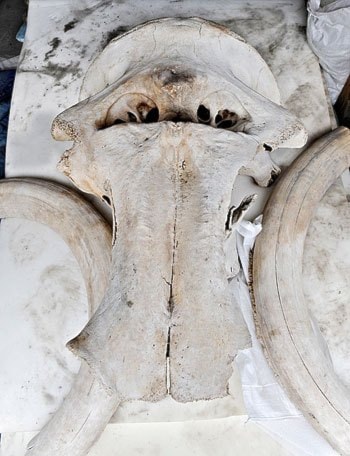Despite their eventual extinction, woolly mammoths took good care of their babies.
Teeth from mammoths around Old Crow, which could be as old as 150, 000 years, show they started eating plants later in life than most modern elephants.
That suggests mammoth mommies nursed their babies longer.
“It would be particularly useful during the winter,” says Jessica Metcalfe, an earth sciences PhD at the University of Western Ontario who uncovered this late-weaning practice.
Today, baby elephants make easy prey for African lions. As well, they are a good food source because one elephant will feed a lot of lions.
Hunting them is especially easy at night when the giant tuskers can’t see. The wily cats have no such impediment, they have night vision.
The same situation is assumed for earlier big cats, like the sabre-tooth tiger, which shared longer, darker winters on the large grass plains near Old Crow with the woollies, says Metcalfe.
It would have been a good idea for these “baby mammoths to stay really close to their mothers, for security,” she says.
Metcalfe predicts mammoths from locations farther south, where there would be fewer hours of winter darkness and therefore less danger, would have begun weaning their babies sooner.
However, these possible maternal precautions could have contributed to their extinction.
“It would be an exaggeration to say delayed weaning caused the extinction,” says Metcalfe, adding many other species also died off around the same time and that mammoths lived in many other parts of the world.
However, the added stress of longer periods of nursing could have played its part.
“All these kinds of different behavioural aspects to an animal would impact how it responds to something like climate change or hunting,” says Metcalfe.
As well, in modern elephants and humans, there is a relationship between delaying weaning and reproduction.
In other words: typically the longer mothers nurse, the longer it takes for them to have another baby - which could also hurt the woollies’ defence against a dwindling population.
But discovering that mammoths above the Arctic Circle delayed weaning does not explain why they don’t exist today.
“This is just one little piece of a big puzzle,” Metcalfe says. “But any information that we can learn about past animals is basically a clue about how the world works and how it worked in the past. And obviously everyone wants to know what’s going to happen in the face of future climate change.
“This kind of research isn’t going to give an answer to these questions, but anything we can learn about the past are clues to what might happen in the present.”
The woolly mammoths in the Old Crow area succumbed to extinction during a time of climate change.
Perhaps, these findings can help modern elephants as they face today’s changes in climate.
“I think the more we know about the biology and behaviour of extinct animals, the better we can understand the biology and behaviour of modern animals and maybe even predict how they might respond to things like climate change in the future,” says Metcalfe.
Contact Roxanne Stasyszyn at
roxannes@yukon-news.com
